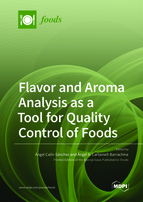Flavor and Aroma Analysis as a Tool for Quality Control of Foods
A special issue of Foods (ISSN 2304-8158). This special issue belongs to the section "Food Analytical Methods".
Deadline for manuscript submissions: closed (20 August 2020) | Viewed by 76131
Special Issue Editors
Interests: evaluation of volatile compounds and the sensory quality of fruits, vegetables, and derived products; evolution of the functional and sensory properties of different fruits and vegetables as affected by different agricultural practices and processing; dehydration of fruits, vegetables, aromatic herbs
Special Issues, Collections and Topics in MDPI journals
Interests: sensory analysis of foods; food quality; food safety; evaluation of volatile compounds of fruits; vegetables and derived products; functionality of fruits and vegetables as affected by different agricultural practices and processing; dehydration of fruits; vegetables; aromatic herbs
Special Issues, Collections and Topics in MDPI journals
Special Issue Information
Dear Colleagues,
The aroma composition of foods has been the subject of considerable research in recent years. It is well known that the presence of volatile compounds and their composition determine the specific aroma of foods and the flavor of the resulting products. The main chemical families present in foods are monoterpenes, monoterpenoids, and phenylpropanoids. In lower amounts, alcohols, sesquiterpenes, sesquiterpenoids, aldehydes, and esters are also found. The composition and concentrations of volatile compounds depend on many factors, including climatic and soil conditions, seasonal variation, agronomical practices, processing, etc. On the other hand, sensory analysis is used to quantitatively determine the intensities of the main sensory properties and attributes of food as well as determine the preference of foods. Such analysis requires the use of a trained panel and regular consumers. As a result of this, the present Special Issue is aimed at gathering outstanding cross-disciplinary approaches (reviews and original research) applying the combination of instrumental analysis (volatile compounds) and sensory analysis as a tool for quality control of foods as affected by both agronomical factors and processing conditions in order to provide very valuable information to farmers and manufacturers.
Dr. Ángel Calín-Sánchez
Prof. Angel A. Carbonell-Barrachina
Guest Editors
Manuscript Submission Information
Manuscripts should be submitted online at www.mdpi.com by registering and logging in to this website. Once you are registered, click here to go to the submission form. Manuscripts can be submitted until the deadline. All submissions that pass pre-check are peer-reviewed. Accepted papers will be published continuously in the journal (as soon as accepted) and will be listed together on the special issue website. Research articles, review articles as well as short communications are invited. For planned papers, a title and short abstract (about 100 words) can be sent to the Editorial Office for announcement on this website.
Submitted manuscripts should not have been published previously, nor be under consideration for publication elsewhere (except conference proceedings papers). All manuscripts are thoroughly refereed through a single-blind peer-review process. A guide for authors and other relevant information for submission of manuscripts is available on the Instructions for Authors page. Foods is an international peer-reviewed open access semimonthly journal published by MDPI.
Please visit the Instructions for Authors page before submitting a manuscript. The Article Processing Charge (APC) for publication in this open access journal is 2900 CHF (Swiss Francs). Submitted papers should be well formatted and use good English. Authors may use MDPI's English editing service prior to publication or during author revisions.
Keywords
- Aroma
- Volatile compounds
- Gas-chromatography
- Sensory analysis
- Flavor
- Quality
- Food control
- Trained panel
- Consumers








